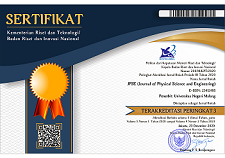Reconstruction of Bandung Groundwater Basin Model Using Schlumberger Configuration Geoelectric Method
Abstract
Bandung is a city with rapid industrial development and a dense population. It causes the need for clean water to be huge, so it impacts groundwater extraction on a large scale. The Bandung Basin, which is a good reservoir for groundwater, will be disturbed if conservation and monitoring efforts are not carried out in the presence of groundwater. This study focuses on reconstructing the groundwater model in the Bandung Basin using the Schlumberger geoelectric method. After taking and analyzing the data, it was found that the resistivity value of the location of the presence of groundwater is depicted into three groundwater basins, namely the Bandung-Soreang groundwater basin, the Lembang groundwater basin, and the Batujajar groundwater basin. Unfettered aquifers, relatively aquitard in nature, are in the upper layer of the coal sandstone, claystone and sandstone units. The confined aquifer in the sand unit is under the sandy claystone layer.
Keywords
Full Text:
PDFReferences
S. Sriyanti, D. Abdurrahman, N. F. Isniarno, R. Amukti, and S. Widayati, “Prediction of time-lapse microgravity value based on groundwater change map in 2003-2010 at Dayeuhkolot industrial area, Bandung,” in J. Phys.: Conf. Ser., vol. 1375, no. 1, p. 012045, 2019, doi: 10.1088/1742-6596/1375/1/012045.
F. Yulianto, N. Suwarsono, S. Sulma, and M. R. Khomarudin, “Observing the inundated area using Landsat-8 multitemporal images and determination of flood-prone area in Bandung basin,” Int. J. Remote Sensing and Earth Sci. (IJReSES), vol. 15, no. 2, pp. 131–140, 2019, doi: 10.32679/jsda.v17i1.654.
I. Maliga, C. Asdak, and E. Y. Winata, “Analisis keberlanjutan pengendalian pencemaran air limbah domestik greywater menggunakan teknologi lahan basah buatan,” J. Sumber Daya Air, vol. 17, no. 1, pp. 13–24, 2021, doi: 10.30536/j.ijreses.2018.v15.a3074.
I. R. H. Sánchez, F. Castellanos, J. H. Barrientos, and S. I. B. Jiménez, “Gravimetric determination of storage coefficient and storage change of groundwater in an uncontrolled and unconfined aquifer,” Natural Resources Res., pp. 1–12, 2021, doi: 10.1007/s11053-021-09904-7.
A. Susanto, A. Kharis, and T. Khotimah, “Sistem informasi geografis pemetaan lahan pertanian dan komoditi hasil panen Kabupaten Kudus,” J. Informatika Ahmad Dahlan, vol. 10, no. 2, p. 103299, 2016.
F. Ridwan, M. Ardiansyah, and K. Gandasasmita, “Pemodelan perubahan penutupan/penggunaan lahan dengan pendekatan artificial neural network dan logistic regression (studi kasus: Das Citarum, Jawa Barat),” Buletin Tanah dan Lahan, vol. 1, no. 1, pp. 30–36, 2017.
W. Ningrum and I. Narulita, “Deteksi perubahan suhu permukaan menggunakan data satelit landsat multi-waktu studi kasus cekungan Bandung,” J. Teknol. Lingkung., vol. 19, no. 2, pp. 145–154, 2018.
A. Pratama, D. E. Irawan, A. Susanto, and R. D. W. Ardi, “Influence of lithology and slope gradient to infiltration of the Mount Malabar, West Java,” in IOP Conf. Ser.: Earth and Environ. Sci., vol. 29, no. 1, p. 012025, 2016, doi: 10.1088/1755-1315/29/1/012025.
A. Purwoarminta, R. F. Lubis, and R. Maria, “Imbuhan air tanah buatan untuk konservasi cekungan air tanah Bandung-Soreang,” RISET Geol. Pertambangan, vol. 29, no. 1, pp. 65–73, 2019, doi: 10.14203/risetgeotam2019.v29.1004.
R. H. Manrulu, A. Nurfalaq, and I. D. Hamid, “Pendugaan sebaran air tanah menggunakan metode geolistrik resistivitas konfigurasi wenner dan schlumberger di kampus 2 Universitas Cokroaminoto Palopo,” J. Fis. Flux, vol. 15, no. 1, pp. 6–12, 2018, doi: 10.20527/flux.v15i1.4507.
H. T. Saranga and S. H. Tongkukut, “Deteksi air tanah menggunakan metode geolistrik resistivitas konfigurasi wenner-schlumberger di masjid kampus Universitas Sam Ratulangi dan sekitarnya,” Jurnal MIPA, vol. 5, no. 2, pp. 70–75, 2016, doi: 10.35799/jm.5.2.2016.12963.
M. Aisyah, W. Utama, and W. Lestari, “Analisis daerah rawan bencana tanah longsor berdasarkan zona water content di Olak Alen Kecamatan Selorejo, Blitar,” J. Tek. ITS, vol. 6, no. 2, pp. C122–C124, 2017, doi: 10.12962/j23373539.v6i2.24902.
E. Kumalajati, “Menentukan arahan fungsi lahan daerah aliran sungai noelmina dengan aplikasi sistem informasi geografis (SIG),” ForestSains, vol. 14, no. 2, pp. 85–90, 2017.
A. Nurfalaq, A. Nawir, R. H. Manrulu, and E. P. Umar, “Identifikasi akuifer daerah Pallantikang Kabupaten Jeneponto dengan metode geolistrik,” J. Fis. Flux, vol. 15, no. 2, pp. 117–127, 2018, doi: 10.20527/flux.v15i2.5158.
M. Muhardi, F. Faurizal, and W. Widodo, “Analisis pengaruh intrusi air laut terhadap keberadaan air tanah di Desa Nusapati, Kabupaten Mempawah menggunakan metode geolistrik resistivitas,” Indonesian Journal of Applied Physics, vol. 10, no. 2, pp. 89–96, 2020.
S. Sohibun, “Aplikasi metode geolistrik konfigurasi schlumberger untuk mengidentifikasi lapisan air tanah di Desa Ulak Patian Rokan Hulu Riau,” J. Fis. Flux., vol. 16, no. 1, pp. 54–60, 2019, doi: 10.20527/flux.v16i1.5651.
A. N. Faris, D. A. Suaidi, S. Sutrisno, M. F. R. Hasan, and A. B. Broto, “Identification of aquifers distribution using geoelectric-resistivity method with schlumberger configuration in Gedangan Village, Malang Regency,” Natural B, J. Health and Environ. Sci., vol. 5, no. 1, pp. 28–34, 2019.
F. Saputra, S. A. Baskoro, S. Supriyadi, and N. Priyantari, “Aplikasi metode geolistrik resistivitas konfigurasi wenner dan wenner-schlumberger pada daerah mata air panas Kali Sengon di Desa Blawan-Ijen,” BERKALA SAINSTEK, vol. 8, no. 1, pp. 20–24, 2020, doi: 10.19184/bst.v8i1.11991.
M. A. Syam, K. Sasmito, A. M. Ghifary, and G. D. Lambe, “Geologi dan identifikasi akuifer dengan metode geolistrik konfigurasi dipole-dipole daerah Bhuana Jaya, Kecamatan Tenggarong Seberang, Kalimantan Timur,” J. Tek. Geol.: J. Ilmu Pengetahuan dan Teknol., vol. 4, no. 1, 2021.
A. R. Hakim and H. Hairunisa, “Pemetaan akuifer di daerah Bima untuk inventarisasi dalam pengelolaan sumberdaya air tanah secara berkelanjutan,” KONSTAN-J. Fis. Pendidik. Fis., vo. 3, no. 2, pp. 74–84, 2018, doi: 10.20414/konstan.v3i2.11.
Copyright (c) 2021 Bayu Himawan, Rian Amukti, Friska Agustin, Mochamad Mussoddaq, Andika Artyanto

This work is licensed under a Creative Commons Attribution-ShareAlike 4.0 International License.
This work is licensed under a Creative Commons Attribution-ShareAlike 4.0 International License




















